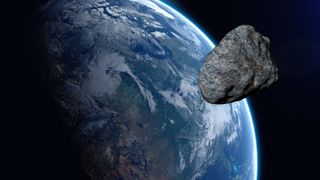2 big asteroids whiz past Earth in the next week. No, they definitely won't hit us.
NASA keeps close tabs on space rocks and has found no imminent threats.

There are two asteroids making very safe flybys of Earth in the coming days.
Despite what you may have read in media reports, no one is issuing any warnings about asteroids 2009 JF1 or 467460 (2006 JF42), which will zoom by our planet on Friday (May 6) and Monday (May 9) respectively. Nor are scientists concerned about the asteroid 418135 (2008 AG33), which passed by our planet already on April 28 despite some media outlets claiming it's coming on Thursday (May 5).
NASA monitors all asteroids via a network of partner telescopes and its Planetary Defense Coordination Office. NASA's Jet Propulsion Laboratory also has loads of asteroid statistics you can review, including a list of prominent upcoming flybys and its Small-Body Database.
There's even a curated list of asteroids available that the agency monitors, which require "more attention" because there is a tiny, statistically improbable chance of impact. Officials update it as new information comes in, including the removal of asteroid Apophis from the list in 2021 after fresh observations showed it poses no threat whatsoever in the next 100 years.
Related: The greatest asteroid missions of all time!
NASA does classify some asteroids as "potentially hazardous," a complex calculation that is related to size (larger than 492 feet or 150 meters) and the distance at which the object approaches Earth, among other factors. But this designation is by no means a warning of an impending problem: There are no known threats to Earth in the coming decades despite ongoing decades of searching.
It is more accurate to say, however, that the zone of space around Earth has a lot of space rocks cruising through it, and as our detection abilities continue to increase we are going to see ever more asteroids reported.
Get the Space.com Newsletter
Breaking space news, the latest updates on rocket launches, skywatching events and more!
So let's talk about what is known about these little worlds in terms of their size and closest expected approach.

2008 AG33 has an estimated diameter between 1,150 and 2,560 feet (350 to 780 meters) and came within about 2 million miles (3.2 million kilometers) of Earth, which is roughly eight times the average distance between Earth and the moon. Admittedly, that was close by cosmic standards, but still a very safe distance to perform a flyby.
The same will be true of the coming two close approaches. The asteroid 2009 JF1, which is only about 30 feet (10 meters) in diameter, was taken off a European Space Agency watch list in February after observations with the Gaia mission found there is no chance it will hit Earth.
"This experiment proves the importance of an astrometric catalogue like Gaia," ESA said, adding that even if it had been about to hit us, the asteroid is "not of significant concern."
As for 2006 JF42, it is more massive, at 1,247 feet to 2,822 feet across (380 to 860 m). That said, its closest approach is a healthy 3.5 million miles (5.7 million kilometers) of our planet, more than 14 times the average Earth-moon distance.
NASA is always reassuring when it comes to these things, including a December 2021 post clearly stating: "Luckily, there are no known asteroid threats to Earth for at least 100 years." So you can rest easy for now, while scientists continue to scan the skies for more information.
Follow Elizabeth Howell on Twitter @howellspace. Follow us on Twitter @Spacedotcom and on Facebook.
Join our Space Forums to keep talking space on the latest missions, night sky and more! And if you have a news tip, correction or comment, let us know at: community@space.com.

Elizabeth Howell (she/her), Ph.D., is a staff writer in the spaceflight channel since 2022 covering diversity, education and gaming as well. She was contributing writer for Space.com for 10 years before joining full-time. Elizabeth's reporting includes multiple exclusives with the White House and Office of the Vice-President of the United States, an exclusive conversation with aspiring space tourist (and NSYNC bassist) Lance Bass, speaking several times with the International Space Station, witnessing five human spaceflight launches on two continents, flying parabolic, working inside a spacesuit, and participating in a simulated Mars mission. Her latest book, "Why Am I Taller?", is co-written with astronaut Dave Williams. Elizabeth holds a Ph.D. and M.Sc. in Space Studies from the University of North Dakota, a Bachelor of Journalism from Canada's Carleton University and a Bachelor of History from Canada's Athabasca University. Elizabeth is also a post-secondary instructor in communications and science at several institutions since 2015; her experience includes developing and teaching an astronomy course at Canada's Algonquin College (with Indigenous content as well) to more than 1,000 students since 2020. Elizabeth first got interested in space after watching the movie Apollo 13 in 1996, and still wants to be an astronaut someday. Mastodon: https://qoto.org/@howellspace
